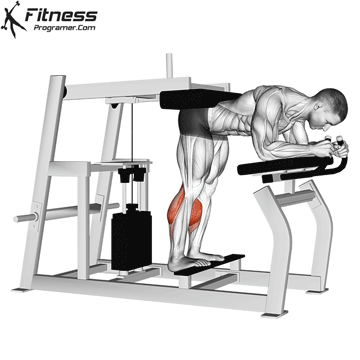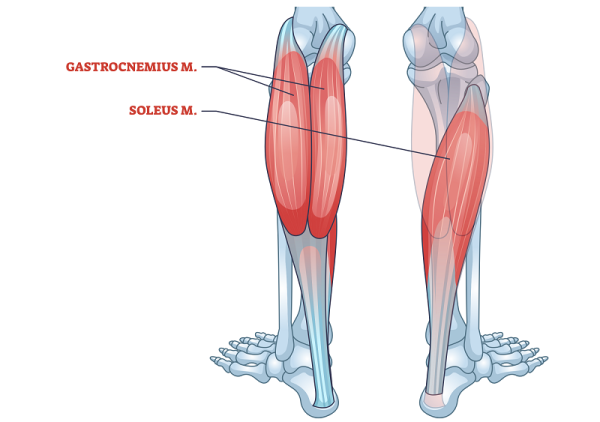Overview
The Lever Donkey Calf Raise is performed on a specialized machine where the lifter bends at the hips and places their lower back or sacrum under a padded lever. With knees extended and feet on a raised platform, the athlete performs standing calf raises through plantarflexion, lifting the lever by pushing through the balls of the feet.
How to Perform the Lever Donkey Calf Raise

Set the Machine: Adjust the height of the padded lever so it rests securely on your lower back or hips when you bend over.
Foot Position: Stand on the calf block with the balls of your feet supported and your heels hanging off. Feet should be hip-width apart or slightly narrower.
Torso Alignment: Bend forward at the hips to about a 90° angle, keeping your spine neutral. The padded lever should rest across your sacrum or upper glutes, not your spine.
Starting Position: Drop your heels below the platform level to achieve a full stretch in the calves.
Initiate the Movement: Press through the balls of your feet to raise the lever by plantarflexing the ankles. Keep your knees straight throughout the movement.
Peak Contraction: At the top, pause for 1–2 seconds while actively squeezing the calves.
Controlled Lowering: Slowly lower the lever until your heels are below parallel to stretch the muscle fully.
Repeat: Perform the desired number of reps with controlled tempo and full range of motion.
Tips for Proper Form
Keep knees fully extended to maximize gastrocnemius activation.
Focus on tempo—use a 2-second stretch, 1-second lift, and 2-second eccentric.
Use a neutral spine throughout. Avoid rounding the back or hyperextending the neck.
Place feet mid-platform to prevent slippage and maintain pressure on the balls of the feet.
Squeeze the calves hard at the top to increase time under tension and build mind-muscle connection.
Common Mistakes to Avoid
Bending the knees, which shifts emphasis to the soleus.
Rounding the spine, especially under heavy loads.
Bouncing at the bottom, which reduces time under tension and risks Achilles strain.
Using too much weight, leading to short, incomplete reps.
Standing too upright, reducing the mechanical stretch of the gastrocnemius.
Benefits of the Lever Donkey Calf Raise
Targets gastrocnemius at full stretch due to extended knees and bent hips.
Eliminates the need for a training partner, unlike the traditional version.
Enables safe progressive overload via plate loading or pin selection.
Reduces spinal compression compared to barbell standing variations.
Enhances ankle plantarflexion strength, important for jumping and sprinting.
Ideal for bodybuilders seeking upper calf thickness and shape.
Compatible with drop sets and tempo training for hypertrophic stimulus.
How to Incorporate Into Your Routine
For Beginners: Use light resistance and focus on controlled tempo and full ROM. Aim for 2–3 sets of 10–12 reps, twice weekly.
For Hypertrophy: Use moderate to heavy loads for 3–5 sets of 12–15 reps. Emphasize peak contraction and slow negatives for calf growth.
For Strength: Perform 4–6 sets of 8–10 reps with heavier weight and longer rest periods. Focus on explosive concentric and controlled eccentric phases.
For High-Frequency Calf Training: Rotate lever donkey calf raises with standing, seated, and unilateral variations across 3–4 weekly sessions.
Donkey Calf Raise: Muscles Worked

Frequently Asked Questions
How is this different from the standing calf raise machine?
The bent-over position of the donkey raise stretches the gastrocnemius more effectively. Standing calf raises keep the hips neutral, limiting that stretch.
Is the lever version better than the partner donkey calf raise?
It’s safer, more consistent, and easier to load progressively—making it a better choice for most lifters without sacrificing effectiveness.
Can I train both calves at once or should I isolate?
The lever donkey calf raise is designed for bilateral training. If you have asymmetries or coordination issues, follow up with single-leg variations.
How often should I include this in my program?
2–3 times per week, either as your main calf movement or as part of a rotation with seated and standing variations.
Should I go heavy or prioritize volume?
Both can be effective. Start by progressing volume with moderate loads, then cycle in heavier sets to develop strength and density.
